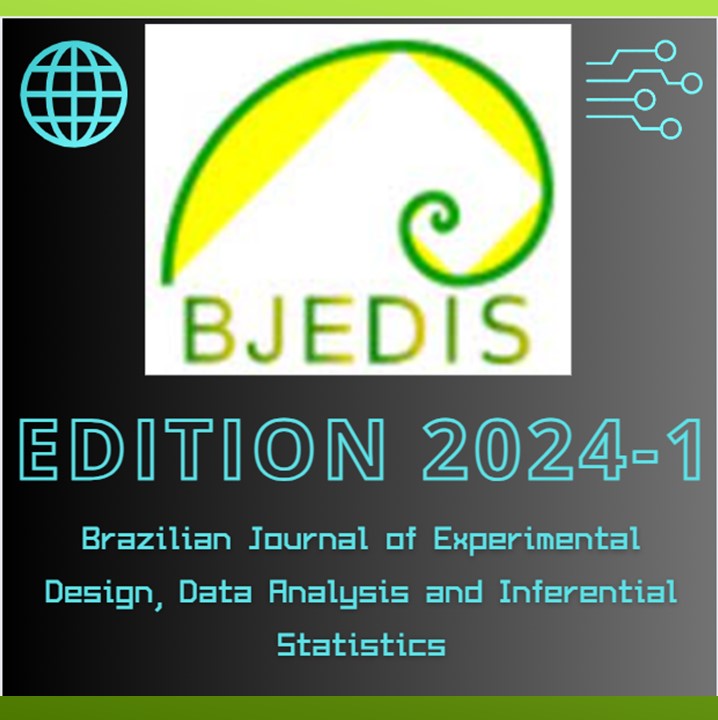HYDRODYNAMIC DIAMETER CONTROL IN THE SYNTHESIS OF CHITOSAN NANOPARTICLES: OPTIMIZATION BY EXPERIMENTAL DESIGN
DOI:
https://doi.org/10.55747/bjedis.v3i1.60159Keywords:
nanoparticles, chitosan, experimental design, hydrodynamic diameterAbstract
Background: Chitosan nanoparticles are an alternative vehicle for drug formulation and delivery. Objective: This study aims at the synthesis of chitosan/tripolyphosphate nanoparticles through an experimental design 32, to evaluate the ideal conditions for obtaining a reduced particle diameter with potential for encapsulation of biomolecules. Method: The nanoparticles were obtained by ionotropic gelation, in 11 experimental conditions. Statistical Analysis were carried out using the software Statistics 7, having as independent variable: the polymer/crosslinker mass ratio and the drip flow rate of the crosslinker. The hydrodynamic diameter of the nanoparticles was the response variable, which was characterized by dynamic light scattering. Results: For the optimized system the results show that the mass ratio between the reactants influences the particle size obtained, and the mass ratio of Chitosan/TPP between 2.25 - 2.50 is the most indicated for obtaining diameters between 20-50 nm. Conclusion: Considering the range of hydrodynamic diameters observed in this study, the nanoparticles are well-suited for utilization as active carriers, specifically targeting organs to enhance the effectiveness of therapies.
Downloads
References
Attia, M. s., Yahya, A., Monaem, N.A., Sabry, S.A., 2023. Mesoporous silica nanoparticles: Their potential as drug delivery carriers and nanoscavengers in Alzheimer’s and Parkinson’s diseases. Saudi Pharm. J. 31, 417–432.
Chen, Y., Liu, Y., Dong, Q., Xu, C., Deng, S., Kang, Y., Fan, M., Li, L., 2023. Application of functionalized chitosan in food: A review. Int. J. Biol. Macromol. 235.
Gao, Xiaoyi, Liu, N., Wang, Z., Gao, J., Zhang, H., Li, M., Du, Y., Gao, Xiang, Zheng, A., 2022. Development and optimization of chitosan nanoparticle-based intranasal vaccine carrier. Molecules 27.
Kong, X., Qi, Y., Wang, X., Jiang, R., Wang, J., Fang, Y., Gao, J., Chu Hwang, K., 2023. Nanoparticle drug delivery systems and their applications as targeted therapies for triple negative breast cancer. Prog. Mater. Sci. 134.
Mehmood, Y., Shahid, H., Barkat, K., Ibraheem, M., Riaz, H., Badshah, S.F., Chopra, H., Sharma, R., Nepovimova, E., Kuca, K., Valis, M., Emran, T. Bin, 2023. Designing of SiO2 mesoporous nanoparticles loaded with mometasone furoate for potential nasal drug delivery: Ex vivo evaluation and determination of pro-inflammatory interferon and interleukin mRNA expression. Front. Cell Dev. Biol. 10, 1–16.
Mekaru, H., 2023. Control of the particle size distribution of organosilica nanoparticles using sonochemistry. Mater. Today Commun. 34.
Muresan, P., McCrorie, P., Smith, F., Vasey, C., Taresco, V., Scurr, D.J., Kern, S., Smith, S., Gershkovich, P., Rahman, R., Marlow, M., 2023. Development of nanoparticle loaded microneedles for drug delivery to a brain tumour resection site. Eur. J. Pharm. Biopharm. 182, 53–61.
Omran, W., Abd El-Mageed, T., Sweed, A., Awad, A., 2022. A modified equation for fitting the shape feature of the entire soil water characteristic curves. Egypt. J. Soil Sci. 0, 0–0.
Pedroso-Santana, S., Fleitas-Salazar, N., 2020. Ionotropic gelation method in the synthesis of nanoparticles/microparticles for biomedical purposes. Polym. Int. 69, 443–447.
Rashighi, M., Harris, J.E., 2017. Clinical translation of an ultrasmall inorganic optical-PET imaging nanoparticle probe. Physiol. Behav. 176, 139–148.
Sreena, R., Nathanael, A.J., 2023. Biodegradable Biopolymeric Nanoparticles for Biomedical Applications-Challenges and Future Outlook. Materials (Basel). 16, 2364.
Downloads
Published
Issue
Section
License
Copyright (c) 2024 Brazilian Journal of Experimental Design, Data Analysis and Inferential Statistics

This work is licensed under a Creative Commons Attribution 4.0 International License.
AUTHORS’ DECLARATION AND COPYRIGHT TRANSFER AGREEMENT
The undersigned authors hereby declare that the submitted manuscript is an original work and has not been previously published or submitted, in whole or in part, to any other journal. The authors further commit not to submit this work to any other journal while it is under consideration by BJEDIS.
We affirm that the manuscript is free from plagiarism, and we accept full responsibility for any allegations of academic misconduct that may arise.
By submitting this manuscript, the authors irrevocably transfer all copyrights of the work—including, without limitation, the rights of reproduction, distribution, translation, and public communication in any form or medium—to BJEDIS. Any breach of this agreement may result in legal action in accordance with the Brazilian Copyright Law (Law No. 9.610 of February 19, 1998).
The authors also declare that there are no conflicts of interest related to this work. All sources of financial support have been properly acknowledged in the funding section of the manuscript.



